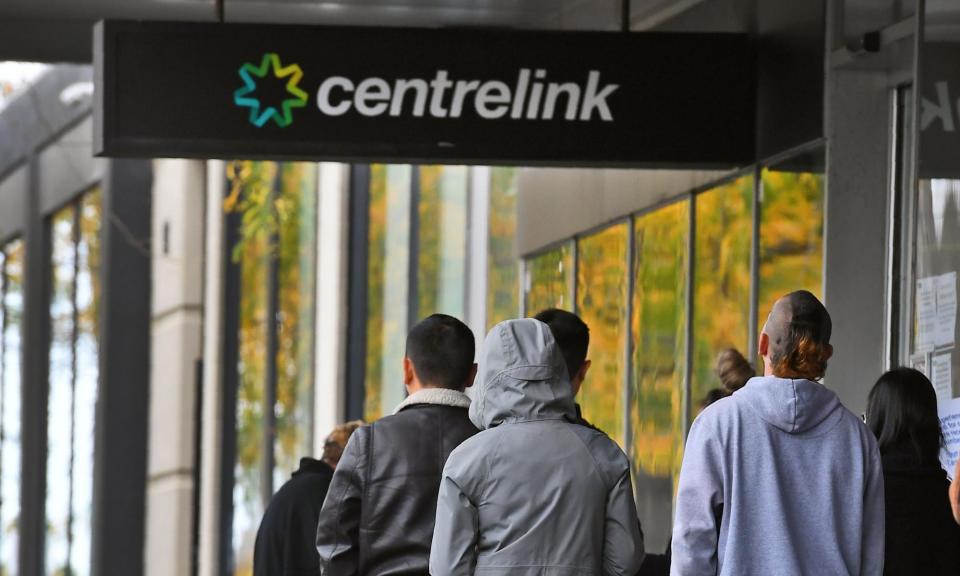Poverty experts tell Labor jobseeker payments should be lifted to 90% of age pension

Jobseeker payments should be raised to 90% of the age pension and indexed to prevent people going “without life’s essentials”, the government’s poverty experts say.
The Economic Inclusion Advisory Committee released its pre-budget report on Friday, warning that jobseeker and other working-age payments were still “too low” despite last year’s $40 increase in the base rate.
The Australian Council of Social Services seized on the report, arguing that raising jobseeker to 90% of the pension rate ($72 a day) would ensure “people can live with dignity”.
The Albanese government has promised further cost-of-living relief in the budget, beyond its revamp of the stage three tax cuts, but has played down expectations of changes to welfare.
The EIAC report found that increasing the jobseeker base rate reduced the gap with the age pension “from around $362 per fortnight to $339 per fortnight, a reduction of 6.4%”.
But “people receiving [jobseeker] payments told the committee that they regularly go without life’s essentials because they simply cannot afford them,” it said.
The government should at least “commit to a timeframe for the full increases of jobseeker and related payments to be implemented, if increases are to be staged”, it said.
The inadequacy of jobseeker was “in part the result of unsatisfactory indexation arrangements over many years”, as the benefit is increased in line with inflation.
“Without change to indexation arrangements, the living standards of recipients of these payments will continue to fall,” it said, suggesting indexation could be improved by considering how jobseeker compares with wage growth.
Related: Brain tumour patient had Centrelink payments suspended while in hospital recovering from surgery
The EIAC also called for an increase in commonwealth rent assistance, finding that indexation had “not kept pace with the spiralling cost of rents, especially in a housing market with a declining proportion of social housing”.
The report called for comprehensive employment services reform, including a full redesign of mutual obligations and an “urgent need to remove automated payments suspensions”. It found the current system was “not fit for purpose and is causing harm”.
The EIAC called to abolish the activity test for the childcare subsidy to guarantee all children access to a minimum three days of high quality early childhood education and care, echoing calls from the women’s economic equality taskforce.
Earlier in April Guardian Australia exclusively revealed the government will lift early childhood educators’ wages as part of the May budget, but it is unclear whether it will agree to requests to remove the activity test.
In January, the government announced changes to stage-three, doubling income tax relief for median income earners and guaranteeing that taxpayers earning less than $45,000, who were due to miss out, would receive a tax cut.
Related: Australia’s unemployment rate rises to 3.8% in March as employers shed more than 6,000 jobs
Crossbench senators and the social services sector argued the changes did nothing for those earning below the tax-free threshold of $18,200 or most recipients of government payments.
On 22 April, the treasurer, Jim Chalmers, said there will be cost of living relief in the budget but “the centrepiece of that, overwhelmingly the biggest part of that, will be a tax cut for every taxpayer to help with the cost of living”.
“But we are considering additional help on top of that and if we can afford that, if it’s affordable, if it’s responsible, if it’s meaningful and it takes some of the edge off inflation rather than add to the inflation problem, then that is attractive to us,” he told reporters in Canberra.
The EIAC found that “any negative effect on incentives to work due to an increase in the jobseeker payment is likely to be small”.
“For people facing economic exclusion, some literature suggests that higher income support payments may improve the capacity to search for and accept employment.”
Acoss chief executive, Cassandra Goldie, said more than one million people on jobseeker and related payment are “barely surviving on deeply inadequate income support”.
“People receiving these payments are eating one meal a day, skipping essential medication and foregoing cooling or heating in a desperate bid to keep a roof over their heads,” she said.
Independent senator David Pocock said the EIAC report shows that “we have a social safety net that is not keeping people safe”.
“The government talks a lot about not leaving anyone behind – this report … gives them a blueprint to achieve this,” he said.

 Yahoo Finance
Yahoo Finance 